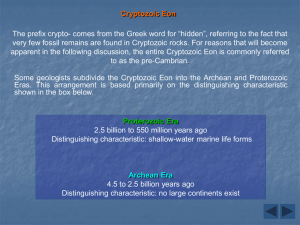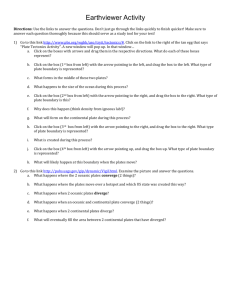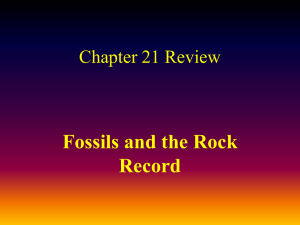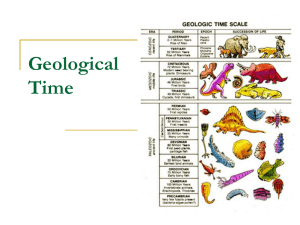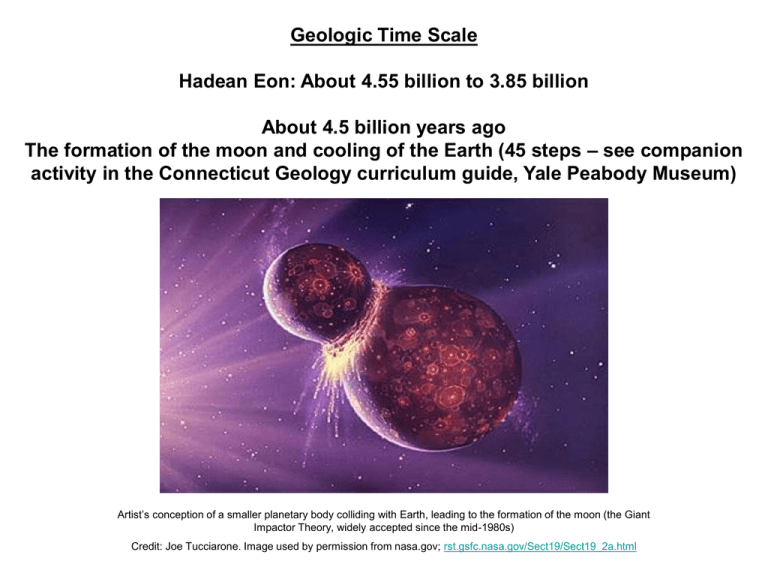
Geologic Time Scale
Hadean Eon: About 4.55 billion to 3.85 billion
About 4.5 billion years ago
The formation of the moon and cooling of the Earth (45 steps – see companion
activity in the Connecticut Geology curriculum guide, Yale Peabody Museum)
Artist’s conception of a smaller planetary body colliding with Earth, leading to the formation of the moon (the Giant
Impactor Theory, widely accepted since the mid-1980s)
Credit: Joe Tucciarone. Image used by permission from nasa.gov; rst.gsfc.nasa.gov/Sect19/Sect19_2a.html
Archean Eon: 3.85 billion to 2.5 billion
Precambrian
About 3.85 billion years ago
Oldest rocks
The air is rich in nitrogen (N) and carbon dioxide (CO2) with
methane (CH4), water vapor (H2O) and other gases, but very
little oxygen (O2) is present. (38 steps)
Used by permission from National Oceanic & Atmospheric Administration; Image source: Earth Science
World Image Bank http://www.earthscienceworld.org/images
Archean Eon: 3.85 billion to 2.5 billion
Precambrian
About 3.4 billion years ago
First cyanobacteria (34 steps)
Stromatolite fossil specimen from the Yale Peabody Museum Paleobotany Division. Stromatolites
are natural formations that occur in shallow water and are the result of layers of sediment being
cemented together by biofilms of cyanobacteria and other microorganisms.
© YPM 51959
Proterozoic Eon: 2.5 billion to 542 million
Precambrian
2.0 billion years ago
Increased concentration of oxygen in the atmosphere from
cyanobacteria metabolism (20 steps)
Used by permission from KidsGeo www.kidsgeo.com
Proterozoic Eon: 2.5 billion to 542 million
Precambrian
1.6 billion years ago
Photsynthesizing organisms (cyanobacteria and plankton) thrive in
shallow seas. These organisms continue to metabolize CO2 and release O2
into the air as a by-product. (16 steps)
Stromatolite fossil specimen from the Yale Peabody Museum. This specimen has been sliced in half and polished to reveal the
interior. Cyanobacteria are the most likely microorganisms involved in the formation of stromatolites like this one.
© YPM 53535A
Geologic Time Scale of CT
1.1 billion years ago: Proto North America (approx. age of the oldest rocks in CT); the land mass that
would eventually form the westernmost part of CT was in the middle of the supercontinent Rodinia
600 – 550 million years ago: Rodinia rifts apart, leaving western CT at the edge of the Iapetos Ocean
Phanerozoic Eon 542 million to
present
Paleozoic Era 542 million to 251
million
Cambrian Period 542 million to 488
million years ago
The “Cambrian Explosion” of marine
animals – many animals inhabit the
shallow, calcareous-mud bottom of warm
shallow oceans along the edges of the
continent, including westernmost
Connecticut.
Abundant hard-shelled trilobites
appear in the sea
(6 steps)
A trilobite fossil (Cambropallas telesto) from the
early Cambrian Period. © YPM IP 37621
Phanerozoic Eon 542 million to present
Paleozoic Era 542 million to 251 million
Ordovician Period 488 million to 444 million years ago
Bryozoans, first vertebrates appear
(5 steps)
Artist’s conception of an astraspid (Astraspis desiderata). Astraspids were a small group of armored, jawless vertebrates from the middle
Ordovician Period. Used by permission; drawing by Phillipe Janvier, http://tolweb.org/Astraspida/16906
Geologic Time Scale of CT
520 – 470 million years ago: Iapetos Ocean grows in size, and then towards the end of this
time period begins to close; Taconic Island Arc forms in the middle of the Iapetos Ocean and
begins moving towards Proto North America; on the far side of the Iapetos Ocean, Avalonia rifts
away from the rest of Gondwana and begins moving towards Proto North America.
Phanerozoic Eon 542 million to present
Paleozoic Era 542 million to 251 million
Silurian Period 444 million to 416 million years ago
Nautiloids common. Oxygen levels in the air are at about 10 percent.
(4.5 steps)
A nautiloid fossil (Bickmorites bickmoreanum) from the middle Silurian Period. ©YPM IP 19158
Geologic Time Scale of CT
470 – 440 million years ago: Taconic Island Arc collides with Proto North America and creates mountains
(Taconic Orogeny); Avalonia continues to move towards Proto North America; Rheic Ocean between
Avalonia and Gondwana expands.
Phanerozoic Eon 542 million to present
Paleozoic Era 542 million to 251 million
Devonian Period 416 million to 359 million years ago
First sharks; earliest terrestrial animals, amphibians and wingless
insects appear (4 steps)
Used by permission from Florida Center for Instructional Technology, 2009
Geologic Time Scale of CT
440 – 400 million years ago: Taconic Mountains erode and Avalonia continues to move
towards Proto North America.
400 – 350 million years ago: The Iapetos Ocean disappears as Avalonia collides with Proto
North America; oceanic crust is pushed into the continent, causing the seafloor muds to
metamorphose into gneiss and schist. Volcanic island arcs and distinct regions of the Iapetos
Ocean form geologic terranes in New England. The Rheic Ocean starts to close, and
Gondwana begins to move towards Proto North America.
Phanerozic Eon 542 million to present
Paleozoic Era 542 million to 251 million
Carboniferous Period 359 million to 299 million
Mississippian Epoch 359 million to 318 million years ago
High oxygen levels (25-30% compared to 21% today) allow insects like
dragonflies to grow large (50 cm wingspan!) despite primitive respiratory
systems; ferns common; frogs develop. Great swamps form coal deposits
around the world. (3.5 steps)
Dragonfly (Meganeuropsis) from The Age of Reptiles Mural by Rudolph F. Zallinger.
© 2010 Yale Peabody Museum of Natural History, Yale University
Geologic Time Scale of CT
350 – 310 million years ago: The Rheic Ocean disappears as Gondwana collides
with Proto North America; massive mountain-building (Alleghenian Orogeny).
Phanerozoic Eon 542 million to present
Paleozoic Era 542 million to 251 million
Carboniferous Period 359 million to 299 million
Pennsylvanian Epoch 318 million to 299 million years ago
Appalachian Mountains formed; first conifers appear; coal deposited
in eastern Ohio; first sauropsids (the group of organisms that gave
rise to reptiles) (3 steps)
Marine iguana (Amblyrhynchus cristatus) from the Galapagos Islands, Ecuador. Photo Greg Watkins-Colwell © YPM R24134
Geologic Time Scale of CT
310 – 290 million years ago: Gondwana continues to push into Proto North America;
continued mountain-building (Alleghenian Orogeny).
Phanerozoic Eon 542 million to present
Paleozoic Era 542 million to 251 million
Permian Period 299 million to 251 million years ago
Synapsids, a group of animals that included the ancestors of
mammals, flourished in the Permian Period. Pangaea forms. Mass
extinction, especially of marine life, at end of Permian. (2.5 steps)
Dimetrodon, a synapsid, fromThe Age of Reptiles Mural by Rudolph F. Zallinger.
© 2010 Yale Peabody Museum of Natural History, Yale University
Geologic Time Scale of CT
290 – 270 million years ago: Gondwana stops advancing on Proto North America;
Pangaea forms. Eastern pegmatites form.
Phanerozoic Eon 542 million to present
Mesozoic Era 251 million to 65.5 million
Triassic Period 251 million to 201.6 million years ago
Life takes tens of millions of years to recover from the Permian-Triassic
extinction. More extinction marks the end of the Triassic, possibly due to a
meteorite impact or huge volcanic eruption, eliminating the large land reptiles
and allowing dinosaurs to expand. Dinosaurs appear; first mammals (small,
rodent-like creatures). Pangaea begins to rift apart. (2 steps)
Drawn by Margaret M. Colbert. Used by permission from American Museum of Natural History
Geologic Time Scale of CT
225 – 200 million years ago: Pangaea begins to rift apart. Atlantic Ocean begins to grow as Africa moves
East; Hartford Basin forms in an adjacent rift valley.
Phanerozoic Eon 542 million to present
Mesozoic Era 251 million to 65.5 million
Jurassic Period 201.6 million to 145.5 million years ago
Dinosaurs dominate; flying reptiles appear; first known bird
(1.5 steps)
Left: Apatosaurus and Stegosaurus, two of the most iconic dinosaurs of the Jurassic Period. Right: Close-up of a flying reptile (Rhamphorhynchus).
Both images from The Age of Reptiles Mural by Rudolph F. Zallinger; images reflect 1940’s conceptions of dinosaur morphology and habits.
© 2010 Yale Peabody Museum of Natural History, Yale University
Geologic Time Scale of CT
200 – 145 million years ago: Atlantic Ocean continues to widen; Hartford Basin stops rifting;
Newark Terrane forms (brownstone, sandstone, traprock)
Phanerozoic Eon 542 million to present
Mesozoic Era 251 million to 65.5 million
Cretaceous Period 145.5 million to 65.5 million years ago
First snakes; first grasses and flowering plants appear; mass extinction of
dinosaurs about 65 million years ago
(.6 steps)
Pacific boa (Candoia carinata). © YPM VZ 024043
Tyrranosaurus rex with other Cretaceous dinosaurs, the flying
reptile Pteranodon, and flowering plants, fromThe Age of Reptiles
Mural by Rudolph F. Zallinger. Image reflects 1940’s conceptions
of dinosaur morphology and habits.
© 2010 Yale Peabody Museum of Natural History, Yale University
Phanerozoic Eon 542 million to present
Cenozoic Era 65.5 million to present
Tertiary Period 65.5 million to 2.6 million
Paleocene Epoch 65.5 million to 55.8 million years ago
Himalayas began to form; many new mammal species; earliest whales and
dolphins; first bats; first large land mammals (.5 steps)
A pair of early horse-like mammals (Merychippus) from The Age of Mammals, a mural by Rudolph F. Zallinger.
Copyright © 1966, 1975, 1989, 1991, 2000 Peabody Museum of Natural History, Yale University, New Haven, Connecticut, USA.
All rights reserved.
Phanerozoic Eon 542 million to present
Cenozoic Era 65.5 million to present
Tertiary Period 65.5 million to 2.6 million
Eocene Epoch 55.8 million to 33.9 million years ago
At the beginning of the Eocene, Earth much warmer than today; climate at
north and south poles similar to modern-day Pacific Northwest (like Seattle,
Washington); rainy, tropical climate and semi-tropical plants in Wyoming.
(.4 steps)
A leaf fossil from an extinct fan palm (Sabalites sp.) collected in
Lincoln County, Wyoming, USA. © YPM 35228 A
Phanerozoic Eon 542 million to present
Cenozoic Era 65.5 million to present
Tertiary Period 65.5 million to 2.6 million
Oligocene Epoch 33.9 million to 23 million years ago
First ape-like primates (.3 steps)
Aegyptopithecus zeuxis skull cast from the Yale Peabody Museum Vertebrate Paleontology collection. Aegyptopithecus is
an early member of the group that led to apes. The original specimen was collected in Egypt. © YPMVP 23975
Phanerozoic Eon 542 million to present
Cenozoic Era 65.5 million to present
Tertiary Period 65.5 million to 2.6 million
Miocene Epoch 23 million to 5.3 million years ago
First grassland ecosystems during the middle Cenozoic Era
(.25 steps)
By Brian Kell, Public domain, via Wikimedia Commons
Phanerozoic Eon 542 million to present
Cenozoic Era 65.5 million to present
Tertiary Period 65.5 million to 2.6 million
Pliocene Epoch 5.3 million to 2.6 million years ago
Panama land bridge forms (.05 steps)
Used by permission from Woods Hole Oceanographic Institute www.whoi.org
Phanerozoic Eon 542 million to present
Cenozoic Era 65.5 million to present
Quaternary Period 2.6 million to present
Pleistocene Epoch 2.6 million to 10 thousand years ago
Dramatic changes in climate; ice sheets cover and uncover Connecticut.
Ice ages, mammoths, and mastodons (.01 steps)
Mammoth (Mammuthus sp.) from The Age of Mammals, a mural by Rudolph F. Zallinger.
Copyright © 1966, 1975, 1989, 1991, 2000 Peabody Museum of Natural History, Yale University, New Haven, Connecticut, USA.
All rights reserved.
Phanerozoic Eon 542 million to present
Cenozoic Era 65.5 million to present
Quaternary Period 2.6 million to present
Pleistocene Epoch 2.6 million to 10 thousand years ago
Neanderthals (Homo neanderthalensis) existed at least 300,000 years ago
and went extinct about 30,000 years ago. Anatomically recognizable modern
humans (Homo sapiens) appeared about 200,000 years ago. (.001 steps)
© YPM; Neanderthal sculpture by Michael Anderson
Phanerozoic Eon 542 million to present
Cenozoic Era 65.5 million to present
Quaternary Period 2.6 million to present
Holocene Epoch 10 thousand years ago to present
Most recent ice age ends about 10,000 years ago. The climate rapidly
warms up to its present state, and plants and animals familiar to us
today inhabit our landscape. “Neolithic” period of human history
(.0001 steps)
Glacier flowing into Prince William Sound, Alaska. Used by permission: Department of the Interior/USGS

